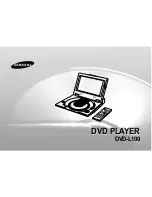
37
submenus, the sub items for AUDIO are displayed as shown in the figure below.
1 DIGITAL OUT
DIGITAL OUT item controls the output condition of digital out (coaxial or optical) connector. There
are 3 values possible for DIGITAL OUT. They are OFF, BITSTREAM and PCM. In the case of
OFF value, No digital signal can be output. Only analog audio can be output. In the case of
BITSTREAM value, the original audio stream recorded on the disc is output through the digital out
connector. In the case of PCM value, the decoded audio stream will be output through the digital
out connector. The relation of amplifier and DIGITAL OUT option is shown below.
Amplifier available
Possible DIGITAL OUT values
No Amplifier
OFF
Digital Decoder Amplifier (Dolby Digital, dts)
OFF, BITSTREAM, PCM (Valid for Dolby Digital)
Stereo or Dolby Prologic Amplifier
OFF, PCM (Valid for Dolby Digital not dts)
2 DOWNMIX (Dolby Digital DVD disc only)
DOWNMIX is used to reproduce the proper analog audio when the audio channel recorded on the
disc differs from the output audio channel configuration. Assume that 5.1 channels audio are
recorded on the disc but you can receive only stereo audio channels. In this case downmix is
unavoidable and you will hear all the channels recorded on disc. There are two ways of
downmixing. One is LT/RT and the other is LO/RO. If you are using Dolby Surround Pro Logic
decoder, please set the downmix mode to LT/RT otherwise LO/RO.
3 DUAL MONOs (Valid for Dolby Digital DVD disc)
DUAL MONOs are two independent mono channels defined in Dolby Digital. DUAL MONO programs
are mainly used for different language versions in one program. This functions in a similar fashion
to TV or VCR supporting secondary audio program. From two MONO channels, STEREO, LEFT
MONO, RIGHT MONO and MIXED MONO may be output in 4 different combinations.
STEREO
L channel on L speaker, R channel on R speaker
LEFT MONO
L channel on L and R speaker
RIGHT MONO
R channel on L and R speaker
MIXED MONO
Mix two mono and output mixed mono on both (L, R) speaker
4 DYNAMIC RNG (Valid for Dolby Digital DVD disc)
A consistent problem in the delivery of audio programming is that different members of the audience
desire or even need different amounts of dynamic range depending on the listening situation.
Original high quality programs, such as feature films, are typically mixed with a wide dynamic
range. Using dialogue as a reference, loud sounds like explosions are often 20 dB louder, and
faint sounds like leaves rustling may be 50 dB quieter. In many listening situations, it is
objectionable to allow the sound to become very loud, and the loudest sounds must be
compressed downwards in level. Likewise the very quiet sounds would be inaudible and must be
brought upwards in level to be heard. If you want to hear the original dynamic range recorded on
disc set the DYNAMIC RNG to 0. Otherwise set to 8 then the dynamic range is reduced by
bringing down the level of the loud sounds and bringing up the level of the quiet sounds.
7.2 Video










































